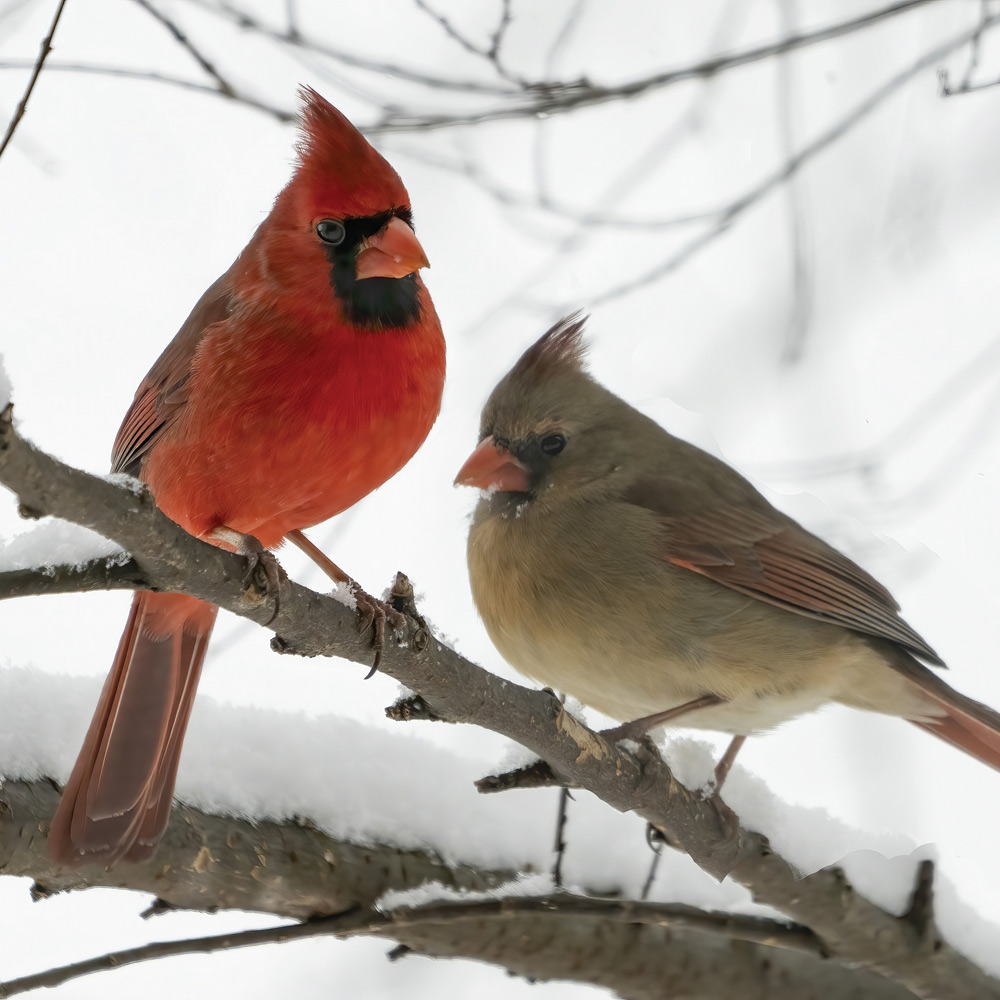A Pretty Red Pair
The Great Outdoors | November 2, 2021

By Jackie Scharfenberg, Forest Naturalist, Wisconsin Department of Natural Resources
“What cheer! What cheer! I’m so purdy, purdy, purdy!”
That’s right! We love to proclaim our beauty throughout our territory making sure all other northern cardinals (Cardinalis cardinalis) in the neighborhood know it. We may be slightly smaller than an American robin, but us males make up for it with our brilliant red feathers, gray-washed wings, red-orange thick bill, distinguished black face, pink-brown legs and feet, and prominent crest. Our females exude a classy eloquence with their pale brown feathers tinged with a warm red on their wings, tail, and crest. We keep our magnificent colors throughout the year. Humans think we’re pretty special, too, making us the official bird of seven states.
HABITAT
When not singing from a high perch, you may have trouble seeing us. We hang out in dense tangles of shrubs and vines, and forage on or near the ground. Our favorite habitats include backyards, parks, woodlots, and shrubby forest edges. If you want to find us, listen for our loud metallic chip call.
MATING
Last spring, I met my mate. We raised our heads high and swayed back and forth while singing softly to each other. Then, I offered her seeds in a kiss-like fashion. She stole my heart with her beautiful singing. Female cardinals are one of only a few female songbirds that sing.
This past summer we raised three broods of young. Each time I followed my mate as she visited several sites. All the while we sang back and forth and carried nesting material in our mouths. She finally found the perfects sites in a thick bush one time, and vines for the other two. She then made a four layered cup nest about four inches across. I helped a bit by bringing her some nesting material and feeding her while she incubated the eggs for about 12 days. Once those eggs hatched, we both went to work feeding those hungry, nearly naked, hatchlings lots of protein-rich insects. Once they left the nest after seven to 12 days, I continued to feed the fledglings while she started the next brood.
DEFENSE
We both defended our territory from intruders. Sometimes we mistook our own reflections in a car mirror or window as another cardinal and did battle with that reflection.
CALLS
We taught our young two dozen song variations and our 16 different calls. Since we learn our songs, those living in separate regions sing slightly different tunes. Think of it like the accents you humans use across the country.
DIET
All summer we foraged as a pair. Ninety percent of our diet consists of seeds and fruits which we supplement with insects. During the fall and winter, we let our guard down to form feeding flocks with other cardinals. There’s safety in numbers with more eyes to watch for hawks, shrikes, and falcons.
Hopefully, we will not become one of the 20 percent of pairs that split up over the winter. I sure love singing our duets for all to hear. “What cheer! What cheer! We’re so purdy, purdy, purdy!”



